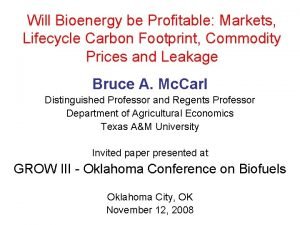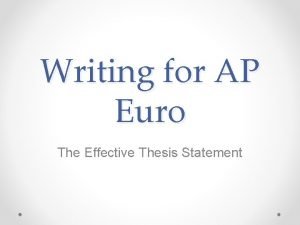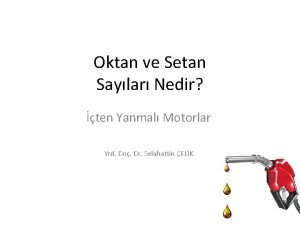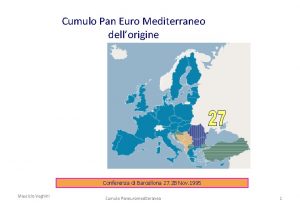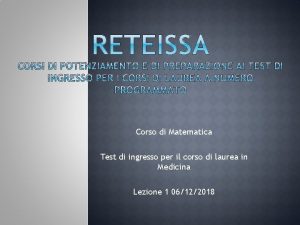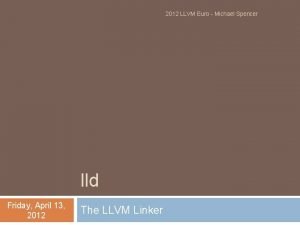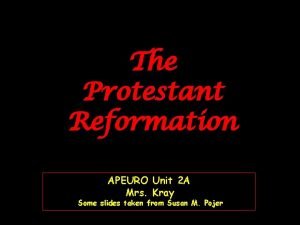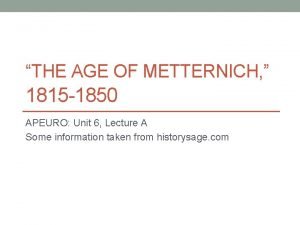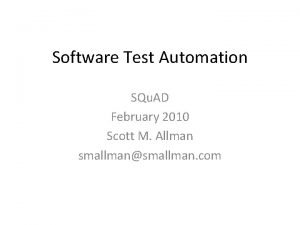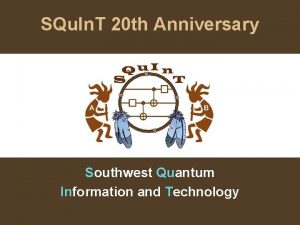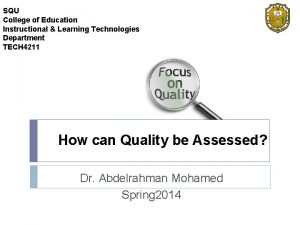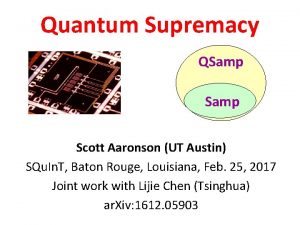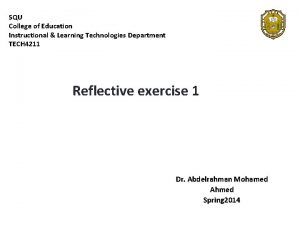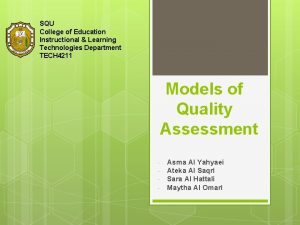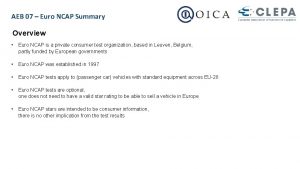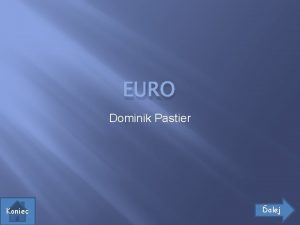www squ edu om Euro Food 2015 1

























- Slides: 25

www. squ. edu. om Euro Food 2015 1 2/27/2021

Effect of Hydrogen Peroxide on Volatile Sulfur Compounds in UHT Milk Zahir Al-Attabi , Bruce R D’Arcy and Hilton C Deeth Department of Food Science and Nutrition, College of Agricultural and Marine Sciences, Sultan Qaboos University, Al-Khod, Sultanate of Oman School of Agriculture and Food Sciences, University of Queensland, Brisbane, 4072, Australia Euro Food 2015 2 2/27/2021

Outline Introduction Objectives Analysis Results & Discussion Conclusion Euro Food 2015 3 2/27/2021

Introduction Cooked flavour in UHT milk is linked to the volatile sulfur compounds (VSCs) , denatured β-lactoglobulin (β-Lg) VSCs (DMS, DMDS, CS 2, Me. SH, COS, H 2 S, DMTS, DMSO, Me 2 SO 2) This off-flavour limits the acceptance of UHT milk Several additives tested (e. g copper, calcium chloride, disodium hydrogen phosphate, sodium iodate/bromate) Not approved by food regulatory agencies in many countries May impart undesirable flavours to milk Euro Food 2015 4 2/27/2021

Introduction Why Hydrogen peroxide (H 2 O 2) ? H 2 O 2 is an effective milk preservative on its own & in combination with heat (Mc. Doneell et al. 2006) H 2 O 2 is a component of LP-system Addition of H 2 O 2 to raw milk, approved by the Codex Alimentarius Commission in 1991 (FAO/WHO 1991) Euro Food 2015 5 2/27/2021

Introduction In the USA, H 2 O 2, (GRAS). It can be added to; - milk (at 0. 05% ) to make certain types of cheese, - whey (at 0. 04%) & starch (at 0. 15%), - wine and instant tea (Sofos and Busta 1999) FAO permits the addition of H 2 O 2 to milk at 0. 05%-0. 25% (500 -2500 mg/L) - all the H 2 O 2 remaining in the milk after processing must converted by catalase into oxygen and water (Tarhan 1995). Euro Food 2015 6 2/27/2021

Introduction In Australia; - H 2 O 2 is an approved processing aid in food with a maximum permitted residue level of 0. 005% (50 mg/L) in the final food (FSANZ 2006). H 2 O 2, sterilizing food packaging materials including UHT milk packages. FDA, limits H 2 O 2 residues to 0. 00005% (0. 5 mg/L)) in the finished food package (CFR 2003). Euro Food 2015 7 2/27/2021

Objectives Aims/study; - the effectiveness of using H 2 O 2 (10, 50, 100, 200, 300 mg/L) in reducing the levels of VSCs in UHT milk, - Its effect on β- lactoglobulin denaturation in UHT and batchheated milk Euro Food 2015 8 2/27/2021

Analysis A. Effect of H 2 O 2 on Sulfur Volatiles Milk sample preparation and H 2 O 2 addition Two batches/ UHT milk Bench-top UHT pilot plant Preheated at 95 o. C for 6 s & then heated at 145 o. C for 6 s 50 m. L or 120 m. L sterile containers, no headspace, stored in the dark at ~22 o. C until analysed Control, No H 2 O 2 Addition of H 2 O 2 (10, 50, 100, 200, 300 mg/L) After Processing Before Processing Euro Food 2015 9 2/27/2021

Bench-top UHT pilot plant Euro Food 2015 10 2/27/2021

A. Effect of H 2 O 2 on Sulfur Volatiles Samples with H 2 O 2 added Before Processing - Analysed Immediately - Day 2, Day 3 After Processing -Analysed after 4 hr - Day 2, Day 3 SPME/GC/PFPD The colour chart referred to concentration ranges of 1 -310 -30 -100 mg. L-1 SPME/GC/PFPD Euro Food 2015 H 2 O 2 residues measured semi-quantitatively at RT for up to one week after processing using Merckoquant® 126 Peroxide strips (Merck, Australia). 11 2/27/2021

Analysis For Volatile sulfur compounds SPME/GC/PFPD GC: Varian CP-3800 Sample: 5 m. L , 10 m. L screw-top vial, fitted with a PTFE-faced silicone septum. Fiber: CAR-PDMS, 85 μm (Supelco, Australia) Extraction time & temperature: 30 o. C /15 min. Triplicate analyses Euro Food 2015 12 2/27/2021

Analysis B. Effect of H 2 O 2 on β-lactoglobulin using UHT & Batch-heated Milk β-lactoglobulin UHT milk sample (section A) Batch heated milk (80 o. C) Milk sample in test tubes heated in a water bath Time: 1 s, 60 s, 240 s, 360 s, 600 s and 1200 s. H 2 O 2: ( 50, 100, 200, 300 mg/L) before & after heating Two batches of each peroxide level Euro Food 2015 Triplicate analyses 13 2/27/2021

Analysis For β-lactoglobulin Denaturation • analysis was performed according to Elliott et al. (2005) • Sample (1 ml) • Eppendorf tube • 30 μL of acetic acid (33%) added • stand for 10 min • 30 μL of 3. 3 M sodium acetate • centrifuged for 20 min at 4500 rpm • supernatant removed carefully and filtered through a 0. 22 μm Millex filter (Millipore Corporation, Bedford, USA). • Shimadzu HPLC system with a SPD M 10 AV UV/Vis detector operated at 205 nm. • standard of β-lactoglobulin • Triplicate analyses Euro Food 2015 14 2/27/2021

Results & discussion A. The effects of H 2 O 2 addition on volatile sulfur compounds Euro Food 2015 15 2/27/2021

Table 1. Volatile sulfur compounds (µg L-1) in UHT milk, with H 2 O 2 added before and after processing, during 3 -d storage a. H 2 S (µg L-1) H 2 O 2 (mg L-1) H 2 O 2 added before processing 1 d 2 d 3 d H 2 O 2 added after processing 1 d 2 d 3 d 0 14. 73± 3. 68 0. 89± 0. 09 0. 70± 0. 09 14. 7± 3. 68 0. 89± 0. 09 0. 70± 0. 09 10 4. 06± 2. 02 0. 68± 0. 12 50 100 200 300 0. 70± 0. 09 0. 59 ± 0. 00 ü Day 1, completely oxidized when added either before or after processing, at all concentrations except 10 mg/L H 2 O 2 ( Conc. below its threshold value (10μg/L). ü H 2 O 2 was more efficient in oxidizing H 2 S when added at 10 mg/L after processing Euro Food 2015 16 2/27/2021

b. COS (mg L-1) H 2 O 2 (mg L-1) H 2 O 2 added before processing H 2 O 2 added after processing 1 d 2 d 3 d 0 1. 07± 0. 27 0. 25± 0. 01 0. 11± 0. 00 10 0. 37± 0. 16 0. 26± 0. 15 0. 08± 0. 02 0. 28± 0. 13 0. 12± 0. 05 0. 07± 0. 01 0. 09± 0. 01 50 100 0. 05± 0. 01 200 300 Ø Completely oxidized when it was added before processing at all concentrations, except for 10 mg/L H 2 O 2 (Day 1). Ø After processing, COS decreased from 0. 28 mg/L at 10 mg/L H 2 O 2 to 0. 05 mg/L at the 100 mg/L H 2 O 2 Ø The addition of 50 mg/L and 100 mg/L H 2 O 2 caused the complete disappearance of COS by day 2 when added after processing. Euro Food 2015 17 2/27/2021

c. Me. SH (µg L-1) H 2 O 2 (mg L-1) 0 10 50 100 200 300 H 2 O 2 added before processing 1 d 2 d 3 d 2. 33± 0. 04 0. 97± 0. 05 0. 51± 0. 00 1. 47± 0. 12 0. 62± 0. 08 1. 47± 0. 20 1. 17± 0. 17 0. 23± 0. 05 H 2 O 2 added after processing 1 d 2 d 3 d 2. 33± 0. 04 0. 97± 0. 05 0. 51± 0. 00 2. 12± 0. 34 0. 78± 0. 05 0. 90± 0. 01 0. 53± 0. 04 0. 25± 0. 07 v Conc. higher than its threshold value in water (0. 2μg/L ) Undetectable at 300 mg/L H 2 O 2. on day one Me. SH conc. Gradually with H 2 O 2 conc. added either before or after processing Completely oxidized by day two for both additions (before or after), except in the 10 mg/L H 2 O 2 samples where it disappeared by day three. The oxidation rate of Me. SH was slightly higher when H 2 O 2 was added after processing. Euro Food 2015 18 2/27/2021

d. DMS (µg L-1) H 2 O 2 (mg L-1) H 2 O 2 added before processing H 2 O 2 added after processing 1 d 2 d 3 d 0 8. 54± 0. 86 6. 26± 0. 50 4. 57± 0. 22 10 7. 66± 1. 33 6. 25± 0. 07 5. 15± 0. 41 6. 68± 1. 33 6. 14± 2. 14 4. 32± 1. 02 50 6. 40± 0. 60 4. 25± 1. 30 3. 07± 0. 80 4. 93± 0. 07 3. 50± 0. 44 2. 70± 0. 63 100 4. 94± 0. 12 2. 25± 0. 32 1. 85± 0. 01 3. 12± 0. 32 1. 23± 0. 42 1. 11± 0. 11 200 2. 24± 0. 32 0. 48± 0. 05 0. 44± 0. 04 1. 02± 0. 38 300 1. 22± 0. 40 0. 52± 0. 11 DMS conc. in control sample was 8. 54 μg/L , < threshold values in milk, 20 μg/L. The DMS conc. gradually decreased as the H 2 O 2 conc. increased, added either before or after The conc. similar in the control sample and the samples with 10 mg/L peroxide even during storage indicating limited oxidation of DMS at low H 2 O 2 concentration. The oxidation rate of DMS was slightly higher when H 2 O 2 was added after processing. Euro Food 2015 19 2/27/2021

e. CS 2 (µg L-1) H 2 O 2 (mg L-1) 0 H 2 O 2 added before processing 1 d 2 d 3 d 3. 29± 0. 95 1. 96± 0. 40 1. 91± 0. 23 H 2 O 2 added after processing 1 d 2 d 3 d 3. 29± 0. 95 1. 96± 0. 40 1. 91± 0. 23 10 3. 25± 0. 69 4. 22± 1. 62 3. 0± 0. 55 2. 53± 0. 49 2. 11± 0. 34 1. 69± 0. 35 50 1. 04± 0. 20 0. 81± 0. 20 0. 62± 0. 20 2. 09± 0. 01 1. 43± 0. 30 1. 18± 0. 25 100 0. 61± 0. 15 0. 46± 0. 11 0. 23± 0. 03 1. 96± 0. 13 1. 44± 0. 15 1. 35± 0. 08 200 0. 38± 0. 04 1. 95± 0. 16 1. 36± 0. 14 1. 23± 0. 06 300 0. 32± 0. 00 1. 87± 0. 03 1. 33± 0. 24 1. 1± 0. 14 The CS 2 conc. control sample was 3. 29 μg/L , < threshold values in milk 100 -1000 μg/L H 2 O 2 was more effective in oxidizing CS 2 when added before processing than after processing At the 200 mg/L & 300 mg/L H 2 O 2 concentrations, CS 2 was undetectable on days two and three. Euro Food 2015 20 2/27/2021

f. DMDS (µg g L-1) H 2 O 2 (mg L-1) H 2 O 2 added before processing H 2 O 2 added after processing 1 d 2 d 3 d 0 10 50 100 0. 06± 0. 02 0. 13± 0. 02 0. 12± 0. 00 200 0. 16± 0. 02 0. 18± 0. 01 300 0. 19± 0. 01 0. 17± 0. 00 Not detected in the control UHT milk Produced when the H 2 O 2 was added before processing at conc. of 100, 200 and 300 mg/L Conc. below the threshold value in milk (21μg/L) It is presumed that the DMDS was formed from Me. SH through oxidation by H 2 O 2. No DMDS was generated when the peroxide was added after processing. Euro Food 2015 21 2/27/2021

Table 3. H 2 O 2 residues (mg L-1) in UHT milk following addition before and after processing H 2 O 2 added (mg L 1) H 2 O 2 added before heating, measured on H 2 O 2 added after heating, measured on 0 h 1 d 2 d 3 d 4 d 7 d 4 h 1 d 2 d 3 d 4 d 7 d 10 1 50 10 1 30 6 1 100 40 4 1 50 30 3 2 200 120 40 20 6 3 150 40 30 30 20 9 300 150 60 40 30 60 30 210 150 100 90 90 90 ü The residues detected when the H 2 O 2 was added after processing were higher than when H 2 O 2 addition was made before processing ü This can be attributed to the heat treatment, since H 2 O 2 can be removed from milk by heating and prolonged storage (Mishra et al. 1985). Euro Food 2015 22 2/27/2021

B. The effects of H 2 O 2 on whey proteins (A) UHT Milk Table 4 Whey protein denaturation in UHT milk with and without H 2 O 2 added before and after processing. Overall, as for β-lactoglobulin, α-lactalbumin was denatured more when H 2 O 2 was added before processing than when added after processing. Euro Food 2015 23 2/27/2021

B. The effects of H 2 O 2 on whey proteins (B) Batch-Heated Milk Table 5 β-Lactoglobulin denaturation (%) in batch-heated milk without and with H 2 O 2 added before and after processing The addition of H 2 O 2 after heating caused less denaturation at the shorter holding times (i. e. 1 s & 60 s) than addition before heating except at 50 mg/L H 2 O 2 where it had minimal effect at all holding times as well as less denaturation compared to the control Euro Food 2015 24 2/27/2021

Conclusion Low concentrations of H 2 O 2 (10 mg/L or 50 mg/L) were sufficient to reduce the level of VSC in the UHT milk under the processing conditions used. One of the major contributors to the cooked flavour, H 2 S, was completely eliminated or reduced to well below its flavour threshold value. Low conc. of H 2 O 2 had no effect on, or reduced, β-lactoglobulin denaturation when added after or before processing, respectively. The addition of H 2 O 2 could be a practical solution to the prevention or alleviation of cooked flavour development in UHT milk However, the levels of H 2 O 2 addition must be within the range permitted by the relevant regulatory jurisdiction. Euro Food 2015 25 2/27/2021
 Squ
Squ Unit 2 food food food
Unit 2 food food food Grazing food chain diagram
Grazing food chain diagram Edu.sharif.edu
Edu.sharif.edu Ap euro thesis formula
Ap euro thesis formula Euro psy
Euro psy Amazone pri
Amazone pri French plan xvii
French plan xvii Romanticism
Romanticism Euro motor nedir
Euro motor nedir Faces moedas euro
Faces moedas euro Währung zur zeit jesu
Währung zur zeit jesu Euro house music
Euro house music Docomo euro labs
Docomo euro labs Eurex trading
Eurex trading Euro global map
Euro global map Cumulo pan euro mediterraneo
Cumulo pan euro mediterraneo Un soggetto abituato a bere un quarto di vino al giorno
Un soggetto abituato a bere un quarto di vino al giorno Dbq rubric ap world
Dbq rubric ap world Ap euro chapter 19
Ap euro chapter 19 Euro inflation
Euro inflation Euro llvm
Euro llvm Lutheran vs catholic
Lutheran vs catholic David ricardo ap euro
David ricardo ap euro Euro data cube
Euro data cube Maz dump trucks
Maz dump trucks
